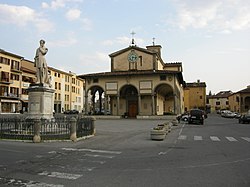Monsummano Terme
| Monsummano Terme | ||
|---|---|---|
| Comune | ||
| Comune di Monsummano Terme | ||

Piazza Giusti.
|
||
|
||
| Location of Monsummano Terme in Italy | ||
| Coordinates: 43°52′N 10°49′E / 43.867°N 10.817°ECoordinates: 43°52′N 10°49′E / 43.867°N 10.817°E | ||
| Country | Italy | |
| Region | Tuscany | |
| Province / Metropolitan city | Pistoia (PT) | |
| Frazioni | Bizzarrino, Cintolese, Grotta Giusti, Grotta Parlanti, Le Case, Monsummano Alto, Montevettolini, Pozzarello, Uggia, Violi | |
| Government | ||
| • Mayor | Rinaldo Vanni | |
| Area | ||
| • Total | 32 km2 (12 sq mi) | |
| Elevation | 20 m (70 ft) | |
| Population (31 May 2015) | ||
| • Total | 21,330 | |
| • Density | 670/km2 (1,700/sq mi) | |
| Demonym(s) | Monsummanesi | |
| Time zone | CET (UTC+1) | |
| • Summer (DST) | CEST (UTC+2) | |
| Postal code | 51015 | |
| Dialing code | 0572 | |
| Patron saint | Maria SS. della Fontenova | |
| Saint day | 9 June | |
| Website | Official website | |
Monsummano Terme is an comune located in the Province of Pistoia, Tuscany, central Italy. It is located in the Valdinievole, and is a popular spa resort.
It is composed by two separate nuclei: Monsummano Alta, of Etruscan origins and with a castle (probably of Lombard origins) and a line of walls, overlook the lower Monsummano Bassa, built starting from 1602 around a sanctuary commissioned by Ferdinand I, Grand Duke of Tuscany.
It was the birthplace of French actor Yves Montand and Italian poet Giuseppe Giusti.
The district is located in the central-eastern Valdinievole, and is bordered to the north by the hills of Montalbano, to the south by the wetland Padule di Fucecchio, to the west by the Piana di Lucca, and to the east by the semi-hilly areas the town of Larciano.
Given the proximity to the Padule, the area displays a wealth of flora and fauna and is a meeting place for birdwatchers. The rivers are very short, of which the Candalla stream is the most prominent, flowing through the city center. The mountains are formed from the Montalbano chain, in which Vinci is located, and Monsummano Alto, which is 340 metres (1,120 ft), known for the unmistakable shape for its quarries, now disused, which have given unnaturally steep slopes on the mountain.
In Etruscan and Roman times, the Valdinievole was classified as a transit site, with some sacred resting places, as evidenced by a bronze piece of art from the 3rd century BC promachos of Hercules, found in 1887 at Castelmartini and today can be found at the city's museum. Going back to the Roman archeological sites (Villa San Paolo at Pozzarello, Vaiano and Segalare), on the slopes of Monte Albano.
The settlement of the castle of Monsummano Alto is documented from 1260, but probably existed since the previous century, or, as some have suggested due to the topology from the Lombard era. The castle was at the center of battles between Florence and Lucca, with its final conquest in 1331. The flat area was swampy (which can still be seen today through the Fucecchio Padule, close by), which became a human settlement in the second half of the 16th century with the construction of several farms and houses. The lower section of the town dates mainly to the seventeenth century, when, after the miraculous apparition of the Virgin on 9 June 1573, the Grand Duke Ferdinand I of Tuscany started the construction of the Shrine of Our Lady of Fontenova (1602-1605) as well as other buildings for the reception of pilgrims, such as Osteria dei Pellegrini, now the city's Museum.
...
Wikipedia


